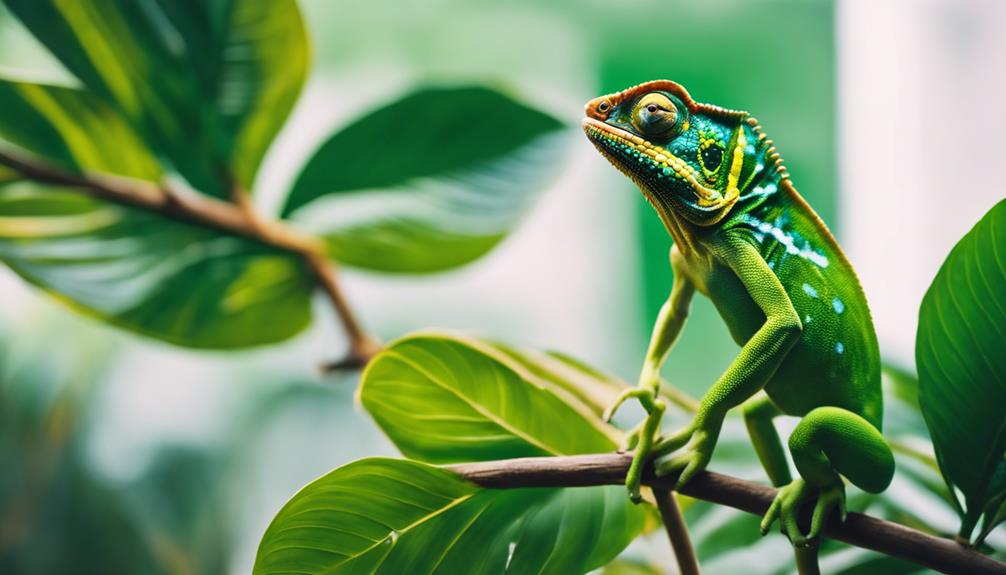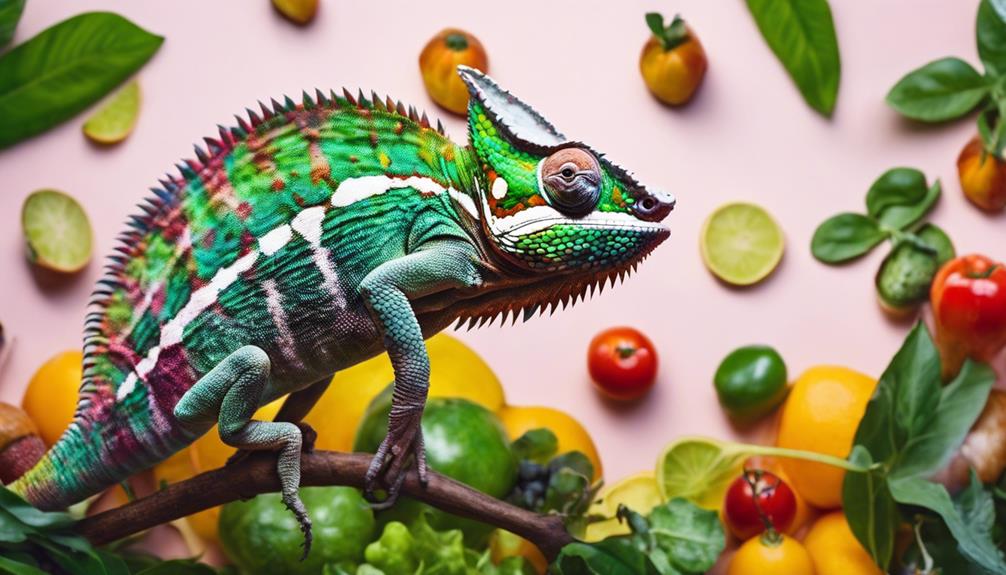Have you ever wondered if Schefflera arboricola could be a safe addition to your chameleon's habitat? Understanding the potential risks and benefits of this plant is essential when caring for your pet.
While some chameleon owners have had success with Schefflera arboricola, there are important considerations to keep in mind.
Stay tuned to learn more about the factors that come into play when deciding whether these plants are suitable for your chameleon's environment.
Potential Benefits of Schefflera Arboricola
Schefflera arboricola plants offer chameleons a range of potential benefits within their habitat. These plants serve as comfortable perches for basking and observation, allowing chameleons to soak up the warmth and observe their surroundings. The dense foliage of Schefflera arboricola also provides essential hiding spots for chameleons, promoting a sense of security and reducing stress for these reptiles. Additionally, the structure and branches of Schefflera arboricola can support chameleons' natural climbing behaviors, encouraging physical activity and exercise.
When incorporated into chameleon enclosures, Schefflera arboricola not only fulfills functional needs but also enhances the aesthetics of the habitat. The lush greenery and naturalistic appearance of these plants create a more visually appealing environment for both the chameleons and their owners. Overall, Schefflera arboricola is a beneficial addition to chameleon habitats, offering a blend of practical utility and visually appealing features that contribute to the well-being of these mesmerizing reptiles.
Potential Drawbacks of Schefflera Arboricola
In chameleon care, it's essential to be aware of potential drawbacks associated with incorporating Schefflera arboricola plants into their habitat. Schefflera arboricola plants contain calcium oxalate crystals, which can be irritating if ingested by chameleons. Some chameleons may exhibit aversion to Schefflera arboricola due to its taste or texture, leading to reduced consumption and affecting its role as a food source or environmental enrichment.
Ingesting Schefflera arboricola in large quantities may result in potential digestive issues or discomfort for chameleons. Hence, it's critical for chameleon owners to monitor their behavior closely when introducing Schefflera arboricola to make sure it's well-tolerated. By observing how chameleons interact with these plants, owners can assess whether any adverse reactions occur and make informed decisions regarding their presence in the chameleon's habitat.
Regular monitoring and careful consideration are key to maintaining the health and well-being of chameleons when incorporating Schefflera arboricola into their environment.
Safe Handling and Placement Tips
When positioning Schefflera arboricola plants in your chameleon habitat, make sure they're placed out of reach to prevent accidental ingestion. Here are some tips to guarantee the safety of your chameleons:
- Securely pot the plant: Make sure the Schefflera arboricola is planted securely to prevent any tipping or falling within the chameleon habitat.
- Regularly inspect for damage: Conduct regular inspections of the plant for any signs of damage, pests, or diseases that could potentially harm your chameleons.
- Seek specific care advice: Consider consulting with a veterinarian or an experienced chameleon owner for specific care advice related to Schefflera arboricola plants.
Monitoring Chameleon Behavior Around Schefflera
Closely observing your chameleon's behavior upon introducing Schefflera arboricola to their habitat is vital for guaranteeing their safety and well-being.
When monitoring your chameleon's interactions with the Schefflera, watch out for signs of nibbling, chewing, or any unusual behavior around the plant. Note if your chameleon shows interest in climbing, using it as a hiding spot, or basking on the Schefflera leaves.
Keep an eye on any changes in appetite, activity levels, or overall behavior near the plant as these can be indicators of how the chameleon is reacting to the new addition.
Document any reactions or behaviors your chameleon exhibits around the Schefflera for further evaluation. By being attentive to your chameleon's behavior and responses to the Schefflera arboricola, you can ensure a safe and enriching environment for your beloved pet.
Consultation With a Reptile Vet
Consulting with a reptile vet can provide valuable insights into the safety and suitability of Schefflera arboricola for chameleons in your care. Reptile vets specialize in understanding the intricacies of chameleon habitats and can offer expert advice tailored to your specific situation. When seeking guidance from a reptile vet regarding plant safety for chameleons, consider the following:
- Reptile vets can assess the risks and benefits of introducing Schefflera arboricola to your chameleon's habitat.
- They may recommend alternative plant options based on your chameleon's species and individual health considerations.
- Consulting with a reptile vet can safeguard the well-being and safety of your chameleons by making informed decisions about the plants in their environment.
Frequently Asked Questions
Is Schefflera Safe for Chameleons?
When considering Schefflera's safety for chameleons, assess chameleon habitat, plant compatibility, and foliage toxicity. Prioritize chameleon diet, indoor plants, and pet safety. Research leaf toxicity, reptile enclosures, and plant research to guarantee proper chameleon care.
Is Schefflera Toxic to Reptiles?
When considering reptile safety, it's important to understand plant toxicity. Some plants can harm arboreal species like chameleons. Be cautious with Schefflera arboricola as not all reptiles react the same. Monitor closely for any adverse effects.
Is Schefflera Arboricola Safe for Pets?
When considering pet-friendly plants for chameleon habitats, prioritize safety by researching plant toxicity. Consult with experts for advice on safe plant options and proper care. Monitor your chameleon's health closely after introducing any new plants to their environment for best well-being.
Is the Schefflera Plant Poisonous?
When considering plant toxicity, remember to prioritize pet safety. Research reptile health and chameleon diet to guarantee indoor plants like Schefflera arboricola won't harm them. Proper plant care is crucial for animal habitats and pet wellness.
Conclusion
To sum up, while Schefflera arboricola may offer aesthetic appeal and potential benefits in a chameleon's habitat, caution should be exercised due to safety concerns.
It's vital to monitor chameleon behavior closely, consult with a reptile vet, and follow safe handling and placement tips when introducing these plants.
Remember, the well-being of your chameleon should always be the top priority when considering new additions to their environment.


